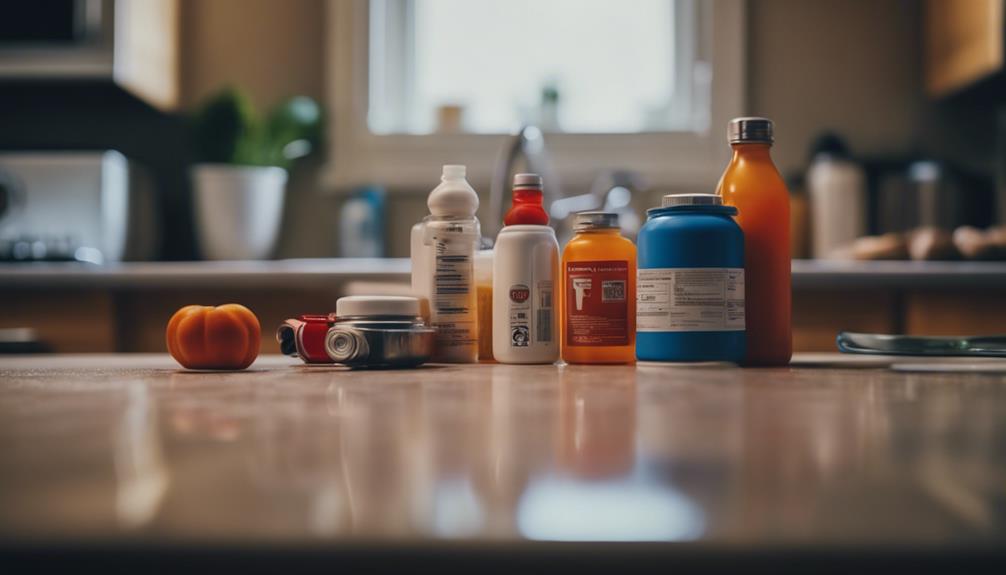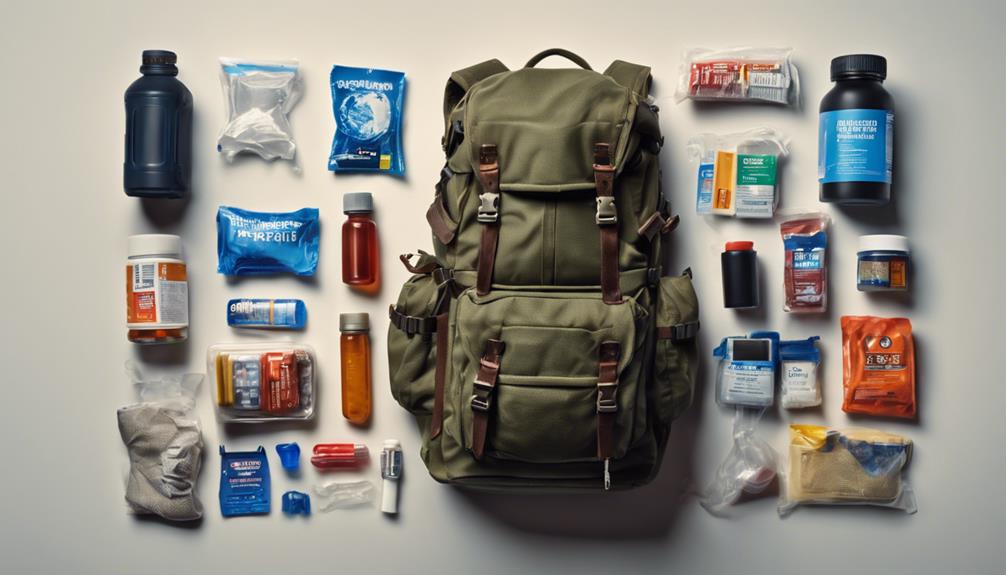Easy tips for everyday readiness include prioritizing food and water supplies, evaluating personal risks, creating a family emergency plan, and balancing bug-in and bug-out strategies. Share preparedness knowledge, avoid complacency, diversify storage locations, and focus on financial preparedness. Keep essentials stocked, update plans regularly, and stay informed to handle unexpected events effectively. By integrating these practical steps into your routine, you can enhance your preparedness effortlessly. Find out more about each tip and additional strategies to boost your readiness.
Key Takeaways
- Start with a 72-hour kit for immediate needs.
- Learn basic skills like first aid and water purification.
- Stock up on non-perishable food and water.
- Rotate supplies to keep them fresh.
- Stay informed about potential risks and updates.
Prioritize Essentials: Food and Water
When preparing for emergencies, prioritize essentials like food and water to guarantee your readiness for unexpected situations. FEMA recommends having a two-week supply of food and water for emergency preparedness.
Stock up on non-perishable items such as canned goods, rice, and pasta for long-term storage. Water is essential for survival, so make sure you have at least one gallon per person per day for drinking and sanitation. To purify water from questionable sources during emergencies, consider investing in a water filter.
Rotate your food supplies regularly to prevent expiration and spoilage, maintaining freshness in critical situations. By focusing on food and water, you're laying a solid foundation for your emergency preparedness.
Conduct Personal Risk Assessments

When preparing for potential emergencies, it's vital to conduct personal risk evaluations. By identifying possible threats and vulnerabilities unique to your circumstances, you can better plan how to respond effectively.
Evaluating individual risks allows for tailored strategies that address your specific concerns and priorities.
Identify Potential Threats
To enhance your everyday readiness, begin by conducting personal risk assessments to identify potential threats you may encounter in your daily life. These assessments involve considering factors such as your location, climate, health conditions, and job type. By understanding the specific threats that could affect you, you can tailor your preparedness efforts to address these vulnerabilities effectively.
Identifying potential threats through personal risk assessments allows you to focus on areas where you may need to improve your readiness. Regularly updating these assessments is vital to make sure that your preparedness efforts remain relevant and efficient over time.
Assess Individual Vulnerabilities
Identifying potential threats through personal risk evaluations is the first step in evaluating your individual vulnerabilities and enhancing your readiness for emergencies and disasters. By conducting personal risk appraisals, you can pinpoint areas where you may be most at risk during crises.
Factors like your location, health conditions, family situation, and skill levels play a vital role in determining your preparedness levels. Evaluating your mental health, ensuring you're physically fit, and having an emergency fund are key aspects of analyzing your vulnerabilities.
Understanding your personal risks allows you to tailor your preparedness plans accordingly and allocate resources effectively. Regularly reviewing and updating your risk assessments is essential to maintaining readiness for various scenarios.
Plan Response Strategies
Start by conducting a personal risk assessment to identify potential threats and vulnerabilities based on your location, lifestyle, and individual circumstances. Assess factors like natural disasters, crime rates, health risks, and financial stability to create a thorough response strategy. Prioritize risks that are most likely to impact you and your family on a day-to-day basis for effective planning. Use the information gathered from the risk assessment to tailor your preparedness efforts and focus on the most relevant scenarios. Regularly review and update your response strategies based on changes in your environment, new risks, or evolving circumstances.
| Make a Plan | Back to the Basics |
|---|---|
| Identify Risks | Stock Up on Essentials |
| Create Response Strategies | Practice Emergency Drills |
| Establish Communication Plans | Learn New Survival Skills |
Maintain a Family Emergency Plan

Make sure your family emergency plan is regularly updated and practiced to enhance readiness during unexpected situations. A family emergency plan serves as an important guide outlining specific actions and responsibilities for each family member in case of a disaster.
It includes essential information such as evacuation routes, designated meeting points, important contacts, and essential supplies to have on hand. Regularly reviewing and updating this plan is critical to guarantee it remains relevant and effective in times of crisis.
Practice emergency drills with your family to familiarize everyone with the plan and build confidence in executing it smoothly when needed. By maintaining a well-structured family emergency plan, you greatly increase your readiness and ability to respond effectively during emergencies.
Balance Bug-In and Bug-Out Strategies

Consider balancing bug-in and bug-out strategies to optimize your preparedness for various emergency scenarios.
Bug-in strategies focus on staying home, utilizing your supplies, and ensuring safety. It's important to prioritize bugging in as it reduces the risks associated with traveling during emergencies. Keep the bulk of your supplies at home to have essential resources readily available when needed.
On the other hand, bug-out strategies involve having a plan to evacuate to a safer location if staying home becomes unsafe. Having a well-rounded approach to preparedness includes considering bug-out plans as a backup to bug-in strategies.
When preparing for emergencies, make sure you have a bug-out bag ready with essentials like food, water, first aid supplies, and important documents. Financial preparedness is also key in balancing bug-in and bug-out strategies. Having emergency funds set aside can help you cover unexpected expenses during crises.
Share Knowledge With Others

When it comes to prepping, sharing your knowledge with others is essential.
By teaching basic skills, you can help create a culture of preparedness in your community.
Encouraging open dialogue about prepping can lead to a more resilient and ready group of individuals.
Teach Basic Skills
Sharing basic survival skills with others fosters a community of prepared individuals ready to handle emergencies effectively. Teaching skills like fire-starting, first aid, and emergency communication is essential. You can impart these skills through hands-on demonstrations, workshops, or online resources.
By educating others on the importance of first aid kits, showing them how to start a fire safely, and teaching them how to communicate during emergencies, you empower them to be self-reliant in challenging situations. When everyone in a community possesses these basic survival skills, the overall preparedness level increases, ensuring a better response to unforeseen events.
Encouraging others to learn these skills not only benefits them individually but also contributes to fostering a culture of readiness and self-sufficiency. Remember, a little knowledge can go a long way in ensuring everyone is better equipped to handle emergencies when they arise.
Promote Preparedness Culture
To foster a culture of preparedness, actively engage in sharing your prepping knowledge with others. Encourage friends and family to start with simple steps like creating an emergency plan or assembling a basic kit. By sharing **practical preparedness tips**, you can help demystify the process and make it less overwhelming for beginners. Offer advice on water storage, food preservation, and essential tools to have on hand during a crisis. Building this collective resilience ensures that more people in your community will be ready to handle unexpected challenges.
Hosting prepping workshops or information sessions can help spread awareness and empower others to be ready for emergencies. Collaborating with community groups or local organizations to organize preparedness events can provide valuable resources and support.
By sharing your prepping experiences and tips, you can inspire others to take proactive steps towards readiness in their own lives. Remember, promoting a culture of preparedness isn't just about individual readiness but also about creating a community that's resilient and capable of handling various challenges.
Your efforts in spreading knowledge and encouraging preparedness can have a ripple effect, ensuring that more people are equipped to face unexpected situations confidently. Start small, but aim to make a big impact by sharing your expertise and encouraging others to join in the preparedness journey.
Encourage Open Dialogue
Engage in conversations with those around you about preparedness, fostering a culture of readiness through open dialogue and knowledge sharing. By sharing knowledge with friends and family, you can help them become more prepared for emergencies. Teaching others basic prepping skills not only equips them but also creates a network of support during crises. Involving others in prepping efforts leads to stronger community resilience, as everyone plays a part in preparing for and responding to emergencies. Open dialogue about preparedness is essential, as it reduces fear and increases confidence in handling unexpected situations. Helping others prepare can bring a sense of fulfillment and strengthen relationships within your community. Start the conversation today and work together towards a more prepared and resilient community.
| Benefits of Encouraging Open Dialogue |
|---|
| – Increased community resilience |
| – Reduced fear during emergencies |
| – Strengthened relationships |
| – Sense of fulfillment |
Focus on Skill Development Beyond Combat

Developing a diverse set of skills beyond combat training is essential for casual preppers to enhance their overall preparedness for various emergency situations. While combat skills are valuable, practical abilities like first aid, orientation, and fire-starting are critical for survival.
Knowing how to purify water, find food in the wild, and construct shelter are also important skills to focus on. Additionally, casual preppers can benefit from learning gardening, food preservation, and basic carpentry for sustainable living during emergencies.
Understanding communication techniques, conflict resolution, and community building goes beyond combat and can be valuable in crisis situations. By diversifying skill development beyond combat, casual preppers can improve their readiness and resilience in different scenarios.
Avoid Complacency

Guard against complacency in your prepping efforts to make sure you're always prepared for unexpected emergencies. Avoid complacency by staying prepared and regularly reviewing your plans.
Complacency can sneak up on even the most dedicated prepper, leading to unpreparedness when disaster strikes. Stay informed about potential threats to prevent complacency in your preparedness efforts.
Regularly reviewing and updating your preps is essential to avoid becoming complacent. Complacency can result in overlooking critical aspects of prepping, such as maintenance and skill development.
Actively engage in prepping activities to stay vigilant and avoid falling into a state of complacency. By maintaining a proactive approach and continuously reassessing your readiness levels, you can make sure that you're well-prepared for any situation that may arise.
Diversify Storage Locations

To enhance your preparedness and reduce vulnerability, consider diversifying your storage locations for prepping supplies. Avoid storing all your preps in one spot to lower the risk of losing everything to looters or disasters.
Spread your supplies across various caches, including underground ones or secure storage units, to increase security. Utilizing alternative locations like vehicle bags can also guarantee access to essentials in different scenarios.
By diversifying storage areas, you maintain a level of readiness even if one location is compromised. This strategy decreases the likelihood of losing all your supplies at once.
Emphasize Financial Preparedness

Make financial preparedness a cornerstone of your prepping strategy to secure your stability in times of uncertainty.
Prioritize building an emergency fund to cover unexpected expenses and maintain financial stability during crises.
Avoid going into debt for prepping purposes, as it can hinder your overall financial preparedness.
Develop good financial habits such as budgeting, saving, and investing to secure your financial future.
Seeking guidance from a financial advisor can also help you tailor your financial plan to meet your prepping goals effectively.
By having a well-structured budget and an adequate emergency fund, you can navigate unexpected events with greater ease and confidence.
Remember, financial preparedness isn't just about the present but also about securing your future.
Cultivating a positive mindset towards financial planning can contribute significantly to enhancing your overall readiness for emergencies.
Handle Unexpected Events and Emergencies

Having essential items readily available can greatly enhance your ability to handle unexpected events and emergencies effectively. Keep a flashlight, multitool, and first aid kit in your car or bag for quick access.
It's important to have emergency contacts saved in your phone and a physical list in case of emergencies. Stay informed about local weather alerts and emergency protocols to be prepared for unexpected events that may arise.
Practice basic first aid skills and understand how to perform CPR in case of emergencies. Consider taking a basic emergency preparedness course to learn essential skills for handling unexpected events confidently.
Frequently Asked Questions
What Is a Reasonable Amount of Prepping?
A reasonable amount of prepping involves having a 3-day supply of food and water, essential supplies, and a basic emergency plan. FEMA recommends a two-week supply for most households. Start with basic steps for everyday readiness.
How Much Does the Average Prepper Spend?
On average, the average prepper spends around $400 to $500 per year on prepping supplies and gear. By budgeting about $30 to $50 monthly, you can gradually build up your supplies without feeling financially overwhelmed.
How to Be a Practical Prepper?
To be a practical prepper, focus on likely scenarios and everyday emergencies. Start with essentials like food, water, and first aid supplies. Balance bugging in and out strategies. Develop a variety of skills and involve family in preparedness.
What Are Basic Prepper Supplies?
To be ready for anything, gather basic prepper supplies like food, water, first aid kits, flashlights, and batteries. Don't forget a multi-tool, emergency blankets, and a whistle. Stock up on hygiene products, cash, and important documents.
Conclusion
To sum up, keep in mind that readiness is key in facing unexpected events. Did you know that according to FEMA, 60% of Americans aren't prepared for a disaster?
By following the easy tips outlined in this article, you can enhance your preparedness and guarantee the safety of yourself and your loved ones.
Stay informed, stay ready, and stay safe!










